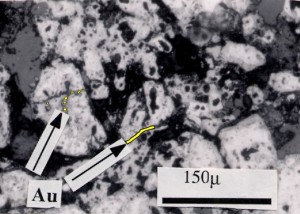Losh, S., Purvance, D., Sherlock, R., Jowett, E. Craig,2005, Geologic and geochemical study of the Picacho gold mine, California: Gold in a low-angle normal fault environment; Mineralium Deposita, v. 40, pp. 137-155
The Picacho gold deposit, just west of the Colorado River 18 miles north of Yuma, Arizona, contained about 600,000 ounces of gold in Mesozoic schists and leucogranites and Tertiary fanglomerates. The mined-out deposit was structurally controlled by a regionally extensive low-angle normal fault (that we call the “Gatuna Detachment Fault”) and subsidiary high-angle faults that were active during the late Eocene. This fault system was partly reactivated in the Miocene, but no mineralization is associated with this later event. The “Gatuna Detachment Fault” contains retrograde greenschist-facies mylonites overlain by and locally incorporated into specularite-and pyrite-bearing cataclasite, which is itself locally brecciated. Gold mineralization was the latest event during the main-stage faulting, being associated only with euhedral pyrite that overgrew the late-stage Eocene brittle fault products, as shown in Figure 1. The lack of association of gold with any other gangue is consistent with its being precipitated as a result of fluid oxidation. Mixing of oxidized and reduced fluids is documented during main-stage detachment faulting at Picacho and elsewhere.
Figure 1. Photomicrograph of oxidized euhedral pyrite that overprints cataclastic leucogranite from the “Gatuna Detachment Fault” in the Picacho Mine, California. Gold is essentially limited to this late-stage pyrite or, uncommonly, has been remobilized during supergene alteration. The late pyrite is preferentially localized by the intersections of low-and high-angle normal faults. Gold mineralization is not found in overlying 32Ma Quechan volcanic rocks or in younger low-angle faults in the mine; it is associated with the latest stage of Eocene low-angle normal faulting.
The Picacho deposit and the “Gatuna Detachment Fault” with which it is associated are characterized by low-salinity (<2 wt% NaCl equiv) fluid and an Au-As-Sb-Hg geochemical assemblage. These characteristics are unlike the high-salinity fluid, and its attendant base-metal rich geochemistry, that is found in many mid-Tertiary metamorphic core complexes in the lower Colorado River area. The difference is probably due to tectonic setting of the older faults – extension within an accretionary terrane (Oyarzabal et al., 1997 Tectonics) that appears to have been infiltrated by relatively fresh meteoric water – as opposed to the younger Basin and Range – style extension, with its closed basins that gave rise to saline brines.
Argon 39-40 dating of lower-plate minerals (Jacobsen 1990 JGR) indicates that major tectonic exhumation took place in the Picacho region from about 38 to 32 Ma. No metamorphic core complex per se of this age is recognized in the region, either because the crustal rheology was different than that which gave rise to the classic core complexes, or because the region has been deformed by later low- and high-angle faulting. No igneous rocks of this age are known anywhere in the area. The lack of ore-stage magmatism as a hydrothermal driving mechanism in the Picacho area points to the sufficiency of hydrogeologic processes that are intrinsic to detachment faults themselves to form sizeable gold deposits.

